

26th September 2025 (13 Topics)
Mains Issues
Context:
The Government of India launched Swachhata Hi Seva (SHS) 2025, themedSwachhotsav, as part of the Swachh Bharat Mission (SBM) to intensify waste management, dumpsite remediation, and community participation, marking a decade since SBM’s inception.
Evolution of the Mission
- Genesis of SBM (2014): Launched on Mahatma Gandhi’s birth anniversary to eliminate open defecation and improve sanitation coverage. Over 12 crore toilets built, reducing open defecation drastically.
- Introduction of Swachhata Hi Seva (SHS)(2017): Annual citizen-driven cleanliness drive to ensure behavioural change through Shramdaan (voluntary service).
- Swachhata Hi Seva 2025: A nationwide campaign (17 Sept–2 Oct) involving ministries, citizens, and local bodies with a focus on Antyodaya se Sarvodaya (uplifting the marginalized first).
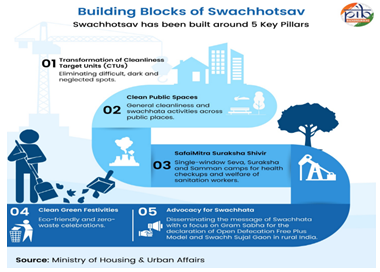
Achievements and Progress
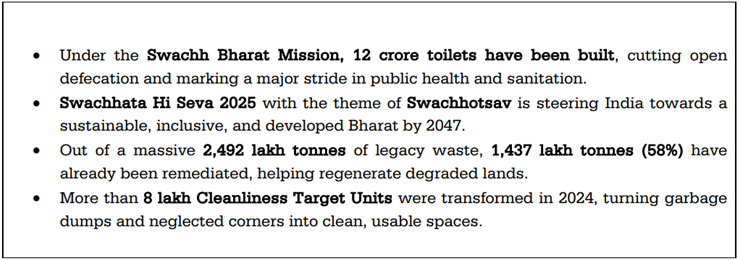
- Waste Processing Expansion: Waste treatment rose from 16% in 2014 to over 81% in 2025, with 1.29 lakh tonnes processed daily.
- Legacy Waste Remediation: Out of 2,492 lakh tonnes of dumpsite waste, 1,437 lakh tonnes (58%) remediated, reclaiming 7,646 acres of land.
- Community Participation: In 2024, 8 lakh Cleanliness Target Units (CTUs) transformed; SHS 2025 emphasises beautification and eco-friendly urban spaces.
- Public Health Impact: WHO estimated 3 lakh under-five child deaths prevented due to improved sanitation and hygiene practices.
Challenges and Concerns
- Behavioural Sustainability: Continued citizen participation post-campaign is difficult.
- Solid Waste Segregation: Household-level waste segregation remains below optimal levels, risking landfill resurgence.
- Urban Local Bodies’ Capacity: Many municipalities face funding and manpower shortages, hampering effective waste-to-energy projects.
- Plastic Waste Management: Despite bans, single-use plastic circulation continues in informal markets.
Case Studies of Innovation
- Agra (UP): Reclaimed 47 acres of dumpsite through bioremediation, creating an Integrated Waste Management City.
- Assam: Women turned invasive water hyacinth into handicrafts and startups developed biodegradable paper from the plant.
- Amarnath Yatra (J&K): Zero-landfill, plastic-free pilgrimage with real-time waste processing and faecal sludge treatment.
Way Forward
- Institutional Strengthening: Empower ULBs with financial autonomy, skilled manpower, and modern waste-processing infrastructure.
- Circular Economy Push: Promote recycling industries, incentivise biodegradable product markets, and expand Extended Producer Responsibility (EPR).
- Technology Integration: Use AI, GIS mapping, and blockchain for waste tracking, dumpsite monitoring, and citizen accountability.
- Behavioural Campaigns: Sustained IEC (Information, Education, Communication) efforts to ingrain cleanliness as a cultural norm.
- Inclusive Participation: Recognition and welfare of sanitation workers to ensure dignity of labour.


Mains Issues
Context:
The National Co-operative Exports Limited (NCEL), registered under the Multi-State Cooperative Societies Act, 2002 in January 2023, has expanded exports worth over ?5,400 crore to 28 countries within two years, positioning itself as the umbrella body for India’s cooperative exports
From Local Cooperatives to Global Markets
- NCEL represents a structural shift in India’s cooperative movement by connecting local produce with international markets, enhancing farmer incomes, and aligning with the vision of Sahakar se Samriddhi (prosperity through cooperation).
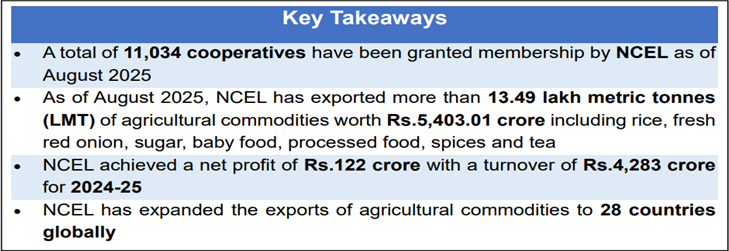
Genesis and Institutional Framework
- Formation (2023): Established with a paid-up capital of ?500 crore by five leading cooperatives — IFFCO, KRIBHCO, NAFED, Amul, and NCDC.
- Legal Basis: Registered under the Multi-State Cooperative Societies Act, 2002, which enables cross-state cooperative operations.
- Mandate: To act as a nodal agency for exports, integrating procurement, storage, processing, branding, certification, and marketing.
Achievements and Contributions
- Membership Base: By 2025, 11,034 cooperatives enrolled, including 10,793 PACS and other state/multi-state cooperatives.
- Export Performance: Exported 49 LMT agricultural commodities worth ?5,403 crore, including rice, sugar, spices, processed foods, and tea.
- Profitability: Net profit of ?122 crore with a turnover of ?4,283 crore in 2024–25, also paying 20% dividend to members.
- Market Outreach: Expanded exports to 28 countries, signed MoUs with 61 importers (e.g., Senegal, Indonesia, Nepal).
- Employment and Livelihood: Strengthened rural job creation through value addition, storage, and packaging.
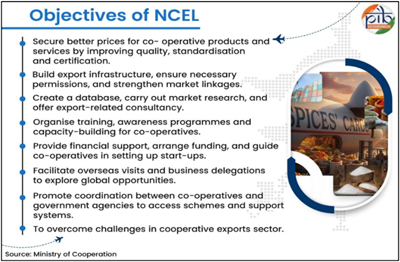
Strategic Significance
- Farmers’ Empowerment: Helps small farmers access global markets by aggregating surplus produce.
- Make in India Push: Enhances India’s agro-processing and branding in global supply chains.
- Whole-of-Government Approach: Collaborates with state nodal agencies, APEDA, and international trade bodies.
- Global Positioning: Enhances branding and competitiveness of Indian cooperative products at internationally benchmarked prices.
Challenges and Concerns
- Competition in Global Markets: Indian cooperatives face strong competition from multinational agribusinesses.
- Quality and Compliance: Meeting international quality, sanitary, and phytosanitary standards remains difficult for small producers.
- Infrastructure Deficit: Cold storage, warehousing, and logistics bottlenecks restrict scale-up.
- Membership Outreach: Need to expand beyond PACS and diversify product portfolio into high-value commodities like organic cotton, marine products, and processed foods.
Way Forward
- Diversification of Exports: Move beyond staples like rice and sugar to niche global demands such as organic produce, pulses, and horticulture.
- International Presence: Establish NCEL offices abroad, especially in Africa and Gulf regions, to strengthen direct linkages.
- Technology Integration: Use digital platforms for market intelligence, demand forecasting, and traceability in supply chains.
- Capacity Building: Train farmers and cooperatives in packaging, certification, and compliance with WTO standards.
- Synergy with Government Schemes: Leverage APEDA, ODOP (One District One Product), and Agri-Infra Fund for infrastructure and market support.


Prelims Articles
Context:
The Registrar General of India (RGI) announced that the Census 2027 will retain the 2011 definition of urban areas, raising concerns about its adequacy in capturing India’s evolving settlement patterns.
Current Definition of Urban (Census 2011)
- Statutory Towns: Notified by state governments, governed by urban local bodies (municipal corporations, councils, nagar panchayats).
- Census Towns: Meet three criteria —
- Population ? 5,000,
- ? 75% of male main working population engaged in non-agricultural activities,
- Population density ? 400 persons per sq. km.
- Limitation: Census towns remain administratively rural despite having urban characteristics.
Limitations of Current Framework
- Outdated Workforce Criterion: Ignores women’s work and mixed livelihoods where individuals engage in both agricultural and non-agricultural activities.
- Underestimation of Urbanisation: Many peri-urban and transitional settlements are excluded. Studies suggest India’s urban population in 2011 may have been 35–57%, not the official 31%.
- Governance Gap: Census towns remain under Panchayati Raj Institutions with limited powers, unlike urban local bodies with greater financial and administrative autonomy.
- Case Study – West Bengal: Despite 526 new census towns in 2011, 251 census towns from 2001 were still not municipalised by 2011, showing governance delays.
Implications of Retaining Old Definition
- Service Delivery Deficit: Settlements with urban needs lack infrastructure (sewage, roads, water supply) due to rural classification.
- Planning Challenges: Misclassification disrupts urban planning, investment priorities, and housing policies.
- Economic Misrepresentation: Expanding gig economy, service jobs, and industrial work in semi-rural areas remain invisible in statistics.
- Policy Inefficiency: Undercounting urbanisation skews resource allocation for Smart Cities, AMRUT, and Jal Jeevan Mission.
|
Fact Box: Statutory vs. Census Towns:
Peri-Urban Areas:
|


Prelims Articles
Context:
A recent academic work (Ranjan, 2025) has introduced the concept of “provincial citizenship” to explain domicile-linked politics in States such as Jharkhand, J&K, and Assam, raising questions about the constitutional framework of a single Indian citizenship.
Concept of Provincial Citizenship
- Definition: An unofficial, politically constructed form of citizenship based on domicile, nativity, or emotional belonging to a State.
- Drivers:
- Nativist politics (sons-of-the-soil sentiment).
- Electoral mobilisation by regional parties.
- Socio-economic grievances of locals against perceived outsiders.
- Consequences: Creates parallel frameworks of identity that compete with constitutional citizenship.
Case Studies of Domicile Politics
- Jharkhand: Post-statehood (2000), domicile policy became a tool for majoritarian grievances against minority elites; demonstrates sub-nationalist assertion across the entire State.
- Jammu & Kashmir: After abrogation of Article 370 (2019), domicile policies extended rights to historically excluded groups (e.g., Valmikis, Gorkhas, West Pakistan refugees).
- Assam: Domicile politics intertwined with migration anxieties and NRC exercise, shaping electoral politics and social tensions.
Constitutional and Historical Concerns
- Constitutional Safeguards:
- Article 14: Equality before law.
- Article 15: Prohibition of discrimination.
- Article 16(2): Prohibits discrimination in public employment on grounds of place of birth/residence (with limited exceptions under Art. 16(3)).
- Article 19: Right to move and reside freely across India.
- SRC Report, 1955: Warned that domicile rules contradict the concept of a common Indian citizenship, urging Parliamentary legislation instead of State-level domicile restrictions.
- Judicial Scrutiny: Supreme Court interventions often required to adjudicate conflicts between migrants’ rights and provincial preferences.


Prelims Articles
Context:
The Union Home Ministry cancelled the FCRA registration of the Students Educational and Cultural Movement of Ladakh (SECMOL), founded by climate activist Sonam Wangchuk, citing violations of the Foreign Contribution (Regulation) Act (FCRA), 2010.
Foreign Contribution (Regulation) Act (FCRA)
Background and Purpose
- Enactment: FCRA was enacted in 1976 during the Emergency period to regulate foreign donations to NGOs, associations, and individuals, aiming to prevent foreign interference in India’s internal affairs.
- Objective: Ensure foreign contributions are used for legitimate purposes (social, cultural, educational, economic, religious) without compromising national sovereignty or democratic values.
- Scope: Applies to all individuals and associations receiving foreign contributions, including NGOs, educational institutions, and religious organisations.
Key Provisions of the FCRA
- Registration
- Mandatory Requirement: Foreign contributions can be accepted only after obtaining FCRA registration.
- Categories: NGOs can register for various categories such as cultural, educational, social, economic, and religious programmes.
- Bank Account: Contributions must be received through a designated FCRA account in a specified branch of State Bank of India, New Delhi.
- Prohibited Activities
- No fictitious entity representation.
- No involvement in religious conversion.
- No history of communal tensions or sedition-related activities.
- Political entities, judges, journalists, and government servants are prohibited from receiving foreign contributions.
- Validity and Renewal
- Validity: Five years.
- Renewal: Required six months before expiry.
- Cancellation: Can be revoked for violations or inactivity for two consecutive years; no re-registration allowed for three years.
Key Amendments
- 2010 Amendment
- Strengthened regulation and compliance.
- Prohibited foreign contribution usage for activities detrimental to national interest.
- 2020 Amendment
- Ban on transfer of foreign funds to other individuals or organizations.
- Reduced permissible foreign contribution usage for administrative expenses from 50% to 20%.
- 2022 Rules Change
- Increased compoundable offences from 7 to 12.
- Raised limit for relative contributions abroad exempt from intimation from ?1 lakh to ?10 lakh.
- Extended time limit for bank account intimation.


Prelims Articles
Context:
Defence Minister Rajnath Singh inaugurated India’s first overseas defence manufacturing facility in Morocco, marking a milestone in India–Morocco strategic relations and India’s defence outreach to Africa.
Strategic Importance
- India–Morocco Relations
- India and Morocco have a longstanding relationship anchored in shared democratic values, historical trade ties, and cultural linkages.
- Morocco serves as a gateway to Africa, offering strategic access to the African defence market.
- Defence Diplomacy
- This initiative reflects India’s growing ambition to expand defence exports and project itself as a global defence manufacturing hub.
- Morocco’s location allows India to establish a strategic foothold in Africa and strengthen South–South defence cooperation.
Defence Export Opportunities in Africa
- Africa’s demand for small arms, bulletproof jackets, armoured vehicles, tanks, and helicopters is growing.
- Russia has traditionally been Africa’s defence supplier, but Ukraine conflict and sanctions disrupted supply chains.
- India’s historical dependence on Russian equipment gives it a comparative advantage in servicing African defence needs.
Strategic Implications
- Geopolitical Context
- India’s move strengthens its strategic autonomy, avoiding alignment with either the S.–China or Russia–West binaries.
- Defence cooperation with Africa can enhance India’s influence in UN peacekeeping, counter-terrorism, and maritime security in the Indian Ocean Region (IOR).
- Economic and Industrial Impact
- Overseas manufacturing increases technology transfer, boosts Make in India objectives, and strengthens India’s defence industrial base.
- Creates potential for Maintenance, Repair, and Overhaul (MRO) facilities in Africa.


Prelims Articles
Context:
Prime Minister Narendra Modi inaugurated the Mahi Banswara Nuclear Power Project in Rajasthan on 25 September 2025, marking a major step under India’s fleet-mode nuclear expansion strategy.
Project Overview
- Location and Capacity:Mahi Banswara project in Rajasthan will house four 700 MWePressurised Heavy Water Reactors (PHWRs).
- Implementing Agency: Developed under AnushaktiVidhyut Nigam Ltd (Ashvini), a joint venture of NPCIL (51%) and NTPC (49%).
- Regulatory Clearance: The Atomic Energy Regulatory Board (AERB) granted siting consent in 2025, later transferred to Ashvini.
- Part of Fleet Mode: Ten identical 700 MWe PHWRs are being built across India for standardisation, cost efficiency, and faster deployment.
|
Pressurised Heavy Water Reactor (PHWR)
|
Achievements and Strategic Importance
- Standardisation Advantage: Uniform design and procurement plans reduce construction time and enhance operational expertise.
- Energy Security: Adds 2,800 MWe to India’s nuclear capacity, reducing overdependence on coal and imported fuels.
- Regional Development: The project is part of a broader infrastructure push worth ?1.22 lakh crore, including solar and transmission projects in Rajasthan.
- Indigenous Technology: Based on India’s proven PHWR design, showcasing self-reliance in nuclear technology.
Broader Nuclear Expansion in India
- Fleet Projects: Alongside Mahi Banswara, projects include Kaiga (Karnataka), Gorakhpur (Haryana), and Chutka (Madhya Pradesh).
- Operational Units:Two PHWRs at Kakrapar (Gujarat) are operational; Rajasthan Unit-7 joined the grid in March 2025, while Unit-8 is under construction.
- Long-term Vision: Nuclear energy is central to India’s goal of 22,480 MWe capacity by 2031.
|
Atomic Energy Regulatory Board (AERB) Establishment and Legal Basis
Mandate and Functions
Organizational Structure
|


Prelims Articles
Context:
A three-day survey has begun across seven biodiversity parks in Delhi to monitor dragonflies and damselflies, as part of a larger effort to assess ecosystem health and biodiversity.
Background of the Survey
- Conducted by students of Shyama Prasad Mukherji College at seven Delhi Development Authority (DDA) biodiversity parks.
- Annual exercise carried out since 2018 to monitor populations of dragonflies and damselflies.
- Surveys at Kamla Nehru Ridge Biodiversity Park and other locations aim to assess habitat health and species diversity.
Ecological Significance of Dragonflies
- Bioindicators of Ecosystem Health
- Dragonflies and damselflies are dependent on wetlands and freshwater ecosystems for breeding and development.
- Presence and diversity indicate healthy aquatic and terrestrial ecosystems.
- Pest Control and Food Web Contribution
- They feed on mosquitoes and other small insects, controlling disease vectors such as malaria and dengue.
- Serve as prey for birds, amphibians, and other wildlife, forming a critical link in the ecosystem.
Observations and Findings
- Sudden surge in dragonfly population attributed to increased water levels, wetland restoration, and improved habitat conditions.
- Restoration projects such as Kamla Nehru Ridge rejuvenation have improved hydrological patterns and created microhabitats like shallow pools and marshy fringes.
- Kamla Nehru Ridge recorded a maximum count of 3,150 dragonflies and damselflies, a significant increase over previous years.
Threats to Dragonfly Populations
- Habitat Loss: Urbanisation, encroachment, and wetland degradation reduce suitable habitats.
- Climate Change: Changing rainfall patterns and temperatures affect breeding cycles.
- Pollution: Water pollution, especially from sewage discharge, negatively impacts larvae development.
- Invasive Species: Alter ecosystem balance and displace native species.
Broader Ecological Implications
- Dragonflies act as early warning indicators for ecosystem changes.
- Decline in their populations signals degradation of wetlands and freshwater resources.
- Conservation of dragonflies contributes to biodiversity preservation, climate resilience, and public health.


Prelims Articles
Context:
A recent Lancet study highlights that while global cancer incidence and mortality rates are declining, India is witnessing an increase, making it a major public health challenge.
Trends in Cancer Incidence and Mortality
- India-specific data:
- Incidence rose from 84.8 per 100,000 in 1990 to 107.2 per 100,000 in 2023 (~15 lakh cases).
- Mortality rose from 71.7 per 100,000 in 1990 to 86.9 per 100,000 in 2023 (~12.1 lakh deaths).
- Global comparison:
- Global incidence decreased from 220.6 per 100,000 in 1990 to 205.1 in 2023.
- Global mortality reduced from 150.7 per 100,000 in 1990 to 114.6 in 2023.
- Future projections: Mortality in India may reduce marginally to 9 per 100,000 by 2025, but incidence will continue to rise due to ageing and growing population.
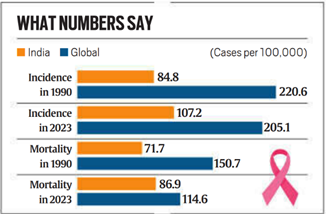
Key Risk Factors in India
- Modifiable factors(contributing to ~42% of deaths):
- Tobacco and alcohol consumption.
- Unhealthy diet and obesity.
- Poor control of hypertension and diabetes.
- High pollution levels.
- Non-modifiable factors:
- Ageing population.
- Genetic predisposition.
Health System Challenges
- Screening campaigns remain inadequate and irregular.
- Focus largely on late-stage diagnosis, not early detection.
- Limited coordination between stakeholders in cancer control programmes.
- High dependence on tertiary care with weak preventive infrastructure.
Impact on LMICs (Low- and Middle-Income Countries)
- Over half of cancer cases and two-thirds of cancer deaths occur in LMICs.
- Rising cases in India reflect broader vulnerabilities of lower-middle-income health systems.


Prelims Articles
Context:
The Defense Research and Development Organisation (DRDO) successfully test-fired the Agni-P missile from a rail-based mobile launcher, placing India among a select group of nations with such capabilities.
Significance of Rail-Based Launchers
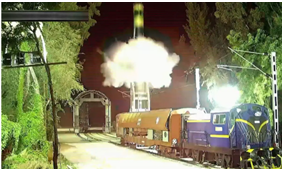
- Strategic deterrence: Provides survivable second-strike capability in case of a nuclear attack.
- Mobility advantage: Launchers can move across India’s 70,000 km rail network, making detection difficult.
- Concealment: Can be hidden in tunnels, forests, or stations, complicating enemy surveillance.
Global Context
- Only a few countries (Russia, US, China) had previously demonstrated capability of launching long-range ballistic missiles from rail-based platforms.
- India’s inclusion strengthens its strategic position in global nuclear deterrence architecture.
Vulnerabilities of Fixed Launch Systems
- Silos and stationary platforms are vulnerable to precision strikes due to advances in satellite imagery, missile accuracy, and surveillance technologies.
- Mobile launchers offer higher survivability by complicating enemy targeting.
Agni-P Missile Characteristics
- Successor to Agni-I and Agni-II
- Medium-range ballistic missile (MRBM) with range of 1,000–2,000 km.
- Capable of carrying both conventional and nuclear warheads.
- Lighter, more agile, and equipped with advanced navigation and guidance compared to earlier Agni series.
Strategic Implications for India
- Enhances India’s credible minimum deterrence under the No-First Use (NFU) policy.
- Provides flexibility and redundancy in deployment strategies.
- Complements submarine-launched ballistic missiles (SLBMs), giving India land-sea dual survivability options.
- Adds resilience to India’s nuclear triad (land, air, sea delivery systems).


Editorials
Context:
The editorial highlights the need for Delhi to engage empathetically and imaginatively with Ladakh to balance security, governance, and empowerment.
Historical and Strategic Context
- Frontier Significance: Ladakh has historically been India’s steadfast frontier, with its people and soldiers defending the region under extreme conditions, including the 1962 war and the 1999 Kargil conflict.
- Union Territory Status: After gaining Union Territory status in 2019, Ladakh received direct empowerment and governance, increasing Delhi’s responsibility to ensure security, development, and local participation.
- Geopolitical Challenges: Ladakh’s strategic location at the confluence of China and Pakistan, combined with its fragile ecology and sparse population, requires careful statecraft and attention.
Governance and Local Engagement
- Administrative Integration: Officials like SD Singh Jamwal, the police commissioner, are directly engaged with local communities, reflecting Delhi’s efforts to understand and address ground realities.
- Local Empowerment: The Apex Body and Kargil Democratic Alliance illustrate how adversaries in Ladakh can unite for collective representation, signaling new political dynamics.
- Community Participation: Ensuring participation of Buddhists, Muslims, and local councils is crucial for building trust, sustaining governance, and promoting development aligned with local priorities.
Balancing Security, Development, and Identity
- Delicate Equilibrium: Delhi must maintain a balance between security, ecological sustainability, and empowerment, avoiding indifference while respecting Ladakh’s unique identity.
- Empathy and Innovation: Decision-making should combine strategic prudence with imaginative solutions, ensuring constitutional integrity and inclusive development.
- Long-Term Vision: Strengthening local leadership, enhancing governance structures, and preserving culture and environment will consolidate Ladakh’s stability and trust in the Indian state.
Practice Question:
“Discuss the strategic, administrative, and socio-cultural challenges of governing Ladakh as a Union Territory. How can India balance security, development, and local empowerment in this sensitive frontier region?”


Editorials
Context:
Pakistan and Saudi Arabia have signed a Strategic Mutual Defence Agreement, raising security and geopolitical concerns for India.
Background and Bilateral Context
- Strategic Defence Agreement: The pact states that “any aggression against either country shall be considered an aggression against both,” highlighting deep military collaboration between Pakistan and Saudi Arabia.
- Indian Diplomatic Efforts: India has sought to isolate Pakistan internationally following the April 2025 terror attack in Pahalgam, yet these efforts have had limited success.
- Historical Relations: Saudi-Pakistan ties have been reinforced over decades, with Pakistan’s military seen as a reliable partner for Saudi regional and domestic security.
Geopolitical Implications
- West Asia Dynamics: The pact occurs amid wider regional changes post-Hamas-Israel conflict in October 2023, affecting strategic alignments in the Gulf and broader West Asia.
- Nuclear Significance: Pakistan, the Islamic world’s only nuclear-armed state, leverages its nuclear status to strengthen ties with Saudi Arabia, gaining strategic and diplomatic leverage.
- Long-Term Planning: Reports indicate that this agreement has been in the making for around three years, reflecting sustained strategic planning by both Islamabad and Riyadh.
Implications for India
- Challenges to Indian Interests: The deal underscores limits of India’s outreach in West Asia and highlights potential divergences between India’s strategic objectives and Saudi-Pakistan priorities.
- Sunnism and Multialignment: The pact is partly driven by ideological alignment around Sunnism, while Saudi Arabia pursues strategic autonomy and multialignment, which may conflict with Indian regional interests.
- Call for Strategic Resolve: India must recalibrate its foreign policy, embrace risks, and act with strategic foresight to safeguard its interests in a rapidly reshaping geopolitical environment.
Practice Question:
“Analyse the implications of the Saudi-Pakistan Strategic Mutual Defence Agreement for India’s security and West Asian policy. Discuss how India can safeguard its strategic interests amid evolving regional alignments.”


Editorials
Context:
U.S. tariffs on Indian exports have highlighted structural and regional trade imbalances, particularly affecting the northeastern States.
Export Concentration &Marginalisation
- Export Centralisation: India’s merchandise exports are heavily concentrated in Gujarat, Maharashtra, Tamil Nadu, and Karnataka, which together account for over 70% of exports, leaving populous States like UP, Bihar, and MP with minimal share.
- Northeast Exclusion: The eight northeastern States, despite having 5,400+ km of international borders, contribute only 0.13% of national exports due to lack of trade corridors, infrastructure, and institutional support.
- Institutional Neglect: The region remains underrepresented in key economic institutions like the Prime Minister’s Economic Advisory Council and the Board of Trade, leading to policy designs that ignore local realities.
Local Economic Impacts
- Tea Economy Vulnerability: Assam, producing over half of India’s tea, faces stagnating prices, labour shortages, and exposure to international market fluctuations exacerbated by tariffs, threatening livelihoods.
- Energy Sector Strain:Numaligarh Refinery expansion relies increasingly on imported crude, including discounted Russian cargoes, making the region vulnerable to U.S. sanctions and global supply chain disruptions.
- Border Trade Decline: Trade with Myanmar has thinned since the 2021 coup, with the scrapping of the Free Movement Regime in 2024 turning once-active corridors into securitised zones, limiting economic integration.
Strategic & Policy Concerns
- Infrastructure Deficit: Roads, cold chains, and warehouses remain inadequate, reducing the northeast’s participation in national and global trade despite India’s free trade agreements and economic initiatives.
- Geopolitical Vulnerability: China’s growing influence in northern Myanmar and ASEAN through infrastructure and militia networks contrasts India’s limited engagement, risking strategic and economic isolation.
- Need for Resilience: Repeated regional omissions highlight the need for dispersal of trade infrastructure and policy attention, ensuring resilience across all regions, not just traditional industrial belts.
Practice Question:
“Examine how regional disparities in India’s export economy, particularly in the northeast, affect national economic resilience and strategic positioning. Suggest measures to integrate neglected regions into national and global trade frameworks.”




